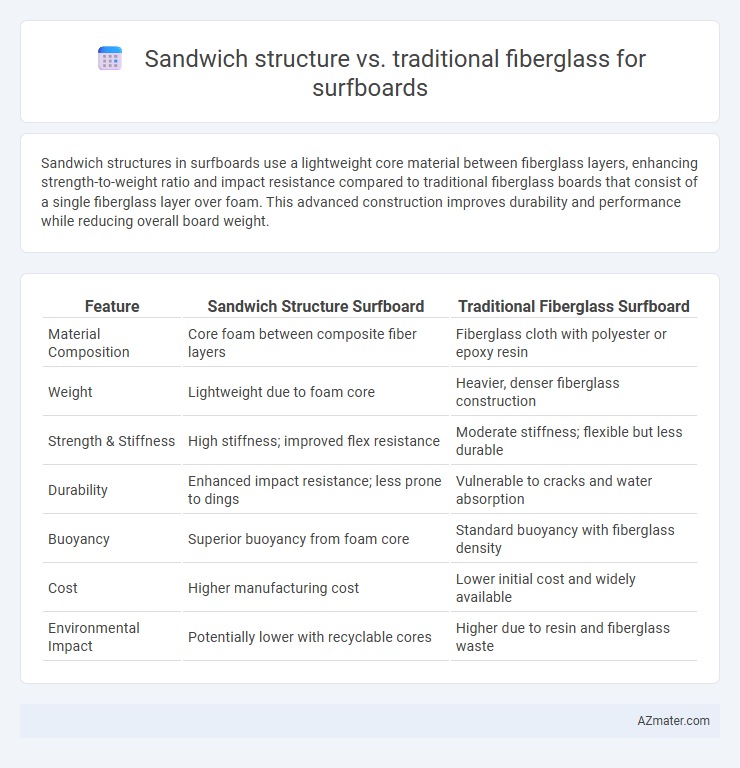Sandwich structures in surfboards use a lightweight core material between fiberglass layers, enhancing strength-to-weight ratio and impact resistance compared to traditional fiberglass boards that consist of a single fiberglass layer over foam. This advanced construction improves durability and performance while reducing overall board weight.
Table of Comparison
| Feature | Sandwich Structure Surfboard | Traditional Fiberglass Surfboard |
|---|---|---|
| Material Composition | Core foam between composite fiber layers | Fiberglass cloth with polyester or epoxy resin |
| Weight | Lightweight due to foam core | Heavier, denser fiberglass construction |
| Strength & Stiffness | High stiffness; improved flex resistance | Moderate stiffness; flexible but less durable |
| Durability | Enhanced impact resistance; less prone to dings | Vulnerable to cracks and water absorption |
| Buoyancy | Superior buoyancy from foam core | Standard buoyancy with fiberglass density |
| Cost | Higher manufacturing cost | Lower initial cost and widely available |
| Environmental Impact | Potentially lower with recyclable cores | Higher due to resin and fiberglass waste |
Introduction to Surfboard Construction
Surfboard construction techniques significantly impact performance, durability, and weight, with sandwich structure and traditional fiberglass being two common methods. Sandwich construction involves layering foam core between fiberglass and epoxy resin, resulting in a lighter, stiffer board that enhances maneuverability. Traditional fiberglass surfboards use a polyurethane foam core wrapped with fiberglass cloth and polyester resin, offering a classic feel but often resulting in a heavier, less durable board prone to dings.
What is Sandwich Structure in Surfboards?
Sandwich structure in surfboards involves layering a lightweight core material, such as EPS foam, between two rigid fiberglass or epoxy skins, creating a strong yet lightweight panel. This construction enhances durability and impact resistance while maintaining flex performance, distinguishing it from traditional fiberglass boards that rely on solid foam cores with a single fiberglass layer. The combination of materials in sandwich structures results in a more resilient surfboard with improved buoyancy and reduced weight compared to conventional fiberglass designs.
Understanding Traditional Fiberglass Surfboards
Traditional fiberglass surfboards consist of a polyurethane foam core wrapped in layers of woven fiberglass cloth, which is then coated with polyester or epoxy resin to create a hard, water-resistant shell. This construction provides durability, flexibility, and a classic feel that experienced surfers appreciate for its responsiveness and repairability. Compared to sandwich structures, traditional fiberglass boards tend to be heavier and less impact-resistant but offer a proven balance of strength and performance crucial for a wide variety of wave conditions.
Material Composition and Layering Differences
Sandwich structure surfboards feature a core made from expanded polystyrene (EPS) or polyurethane foam, surrounded by multiple structural layers including fiberglass and epoxy resin, creating a lightweight yet highly durable board. Traditional fiberglass surfboards typically use a polyurethane foam core with a single outer fiberglass layer and polyester resin, resulting in a heavier and less flexible board. The key difference lies in the sandwich construction's layered composite materials that enhance impact resistance and stiffness compared to the simpler, single-layer fiberglass lamination.
Weight and Strength Comparison
Sandwich structure surfboards utilize composite layers with foam cores, resulting in significantly lighter boards compared to traditional fiberglass models, which rely on heavier resin-saturated glass fibers. The foam core in sandwich construction enhances stiffness and impact resistance, offering superior strength-to-weight ratios under heavy wave conditions. Traditional fiberglass boards provide durability but generally weigh more, which can reduce maneuverability and increase rider fatigue during extended sessions.
Flex Patterns: Ride Feel and Performance
Sandwich structure surfboards feature multiple layers of foam and fiberglass laminated together, providing a more consistent flex pattern that enhances responsiveness and energy return during rides. Traditional fiberglass boards typically exhibit stiffer flex characteristics, resulting in a more rigid feel that can limit maneuverability and dampen subtle wave feedback. The optimized flex of sandwich structure boards improves overall performance by allowing surfers to maintain control and generate speed with greater ease on various wave types.
Durability and Impact Resistance
Sandwich structure surfboards feature a core made of lightweight foam encased between layers of fiberglass or epoxy, providing superior impact resistance and enhanced durability compared to traditional fiberglass boards. Traditional fiberglass boards, constructed with a solid foam core and fiberglass lamination, tend to be more prone to dings and cracks under heavy impact due to less efficient energy dispersion. The sandwich construction's combination of materials absorbs shocks better, resulting in longer-lasting surfboards capable of withstanding rigorous use in various wave conditions.
Manufacturing Processes and Costs
Sandwich structure surfboards feature a core material, such as EPS foam, enclosed between fiberglass layers, allowing automated lamination and reduced resin usage, which lowers manufacturing time and labor costs. Traditional fiberglass surfboards rely on hand-laminated fiberglass cloth with polyester or epoxy resin, increasing manual labor intensity and material waste, leading to higher production expenses. The sandwich method's precise control over material distribution enhances consistency and durability, making it a cost-effective alternative to conventional fiberglass boards.
Environmental Impact and Sustainability
Sandwich structure surfboards utilize foam cores with fiberglass and epoxy layers, offering improved durability and reduced material waste compared to traditional fiberglass boards that rely heavily on polyester resin and heavier glass fibers. The epoxy in sandwich construction emits fewer volatile organic compounds (VOCs) than polyester resin, minimizing environmental pollution and health hazards during manufacturing. Moreover, sandwich boards often feature recyclable or bio-based foam cores, enhancing sustainability by lowering the carbon footprint and facilitating end-of-life recovery.
Choosing the Right Construction for Your Surfing Style
Sandwich structure surfboards offer increased durability and lightweight performance by using a foam core encased between layers of fiberglass and epoxy resin, making them ideal for surfers seeking enhanced maneuverability and responsiveness. Traditional fiberglass surfboards, constructed with a polyurethane core and polyester resin, provide a classic feel with more flex and a smoother ride, preferred by power surfers and those who favor traditional wave styles. Selecting the right construction depends on your surfing style, wave conditions, and desire for board longevity versus performance flexibility.

Infographic: Sandwich structure vs Traditional fiberglass for Surfboard
 azmater.com
azmater.com